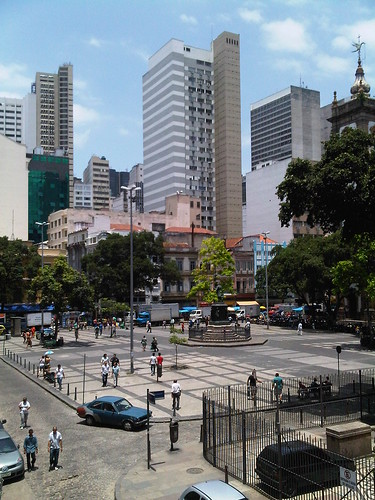
Largo de São Francisco de Paula in the heart of Centro.
Centro, the other neighborhood in Rio de Janeiro where I visited galleries, is distinct in almost every way imaginable from Zona Sul (including the tourist-heavy areas of Copacabana, Ipanema, and Leblon). Many visitors may never leave the confines of Zona Sul during their time in Rio. I speak from experience: this was my third time in Rio, but only my first time exploring Centro. Zona Sul has a laid-back atmosphere, influenced by beach culture, while Centro buzzes with the activity of pedestrians, vendors, and people otherwise seeming to be malandros, who pack its narrow streets.
Centro is Rio’s downtown, a combination of 20th century high-rise buildings functioning as the heart of domestic and international business, mixed with historic edifices, churches, and public squares, which host micro-economies of shops and open-air markets. The galleries in Centro have assimilated to the character of the neighborhood, a complete departure from the sleekness I noticed in Gávea. The prevalent feeling in Centro is one of old-world urban grit transposed by jeitinho Brasileiro.
First up, the gallery A Gentil Carioca (Rua Gonçalves Ledo, 17), founded by the artists Ernesto Neto, Franklin Cassaro, Laura Lima, and Márcio Botner. Its entrance is so completely unassuming that I missed it on my first pass. Upon entering, you proceed up the stairs to the second floor, which has an office with a small collection of works in it. Going up one more level, you reach the gallery space, which has two separate rooms, and a little depressed area that they call the piscina (“swimming pool”), into which you can descend via pool ladder. The exhibition on view was Zum Zum Zum by Cao Guimarães e José Bento, comprising a video of instrumentalists talking about the color of sound, and an installation of music stands in the “swimming pool,” which was somewhat treacherous because the room was pitch black.
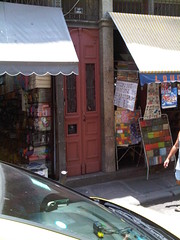

I attempted to visit Centro Municipal de Arte Hélio Oiticica (Rua Luís de Camões, 68), but it was closed for installation. The center is operated by the city and mounts rotating exhibitions. It used to hold Oiticica’s archive of works, until a dispute with his heirs resulted in the transference of the collection back to their private stewardship. In 2009, a significant portion of the collection was destroyed or damaged due to a fire in the home of his brother César Oiticica, where the work was stored. (For further reading, visit Artinfo, The Art Newspaper, or Globo)
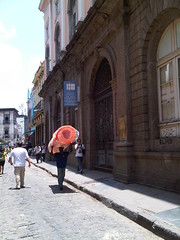
I also attempted to visit the gallery Durex Arte Contemporânea (Praça Tiradentes, 85). After ringing the bell multiple times and many minutes of waiting, I left.
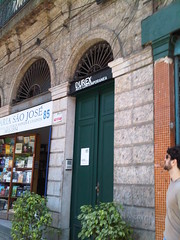
Largo das Artes (Rua Luís de Camões, 2) occupies an airy and spacious loft that looks out over Largo de São Francisco de Paula. The exhibition paired two artists: Osmar Barros’ Me Mostre a Pintura (“Show Me The Painting”) and Ronaldo Grossman’s Homem de Areia (“Sandman”). I enjoyed Barros’ work the most out of any that I saw in a Rio gallery. He reveals hidden colors, such as eggs that when cracked open release two pigments instead of white and yolk. A video documents him chipping away at the drywall to reveal brightly-painted bricks beneath it, an interesting way to play upon the history ingrained in the nineteenth century building that houses the gallery.

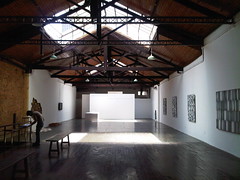


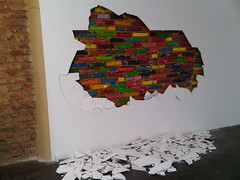
Along the same street as Largo das Artes and Centro Municipal de Arte Hélio Oiticica is Real Gabinete Português de Leitura (Rua Luís de Camões, 30), a singular attraction not to be missed. It is not a gallery or museum, but an historic library dedicated to Portuguese literature and culture. The Neo-Gothic interior is absolutely stunning, as is the volume of rare and antique books it contains. There was also a temporary exhibition drawn from its collection, Imagens da República Portuguesa no Brasil 1910-22 (“Images of the Portuguese Republic in Brazil”). Many of the works on display were caricatures from the popular press, which gave insight to how Brazilians viewed their former colonial master, then struggling with how to exist as a republic (Brazil had been independent of Portugal since 1822, and a republic from 1889).
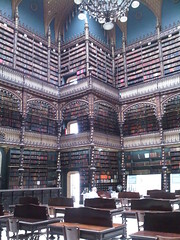
I love your gallery photos, it looks very exciting!
ReplyDelete@Frangipan Thanks very much! Have you been to Rio?
ReplyDeleteNo, but hopefully I will get to South America in 2012!
ReplyDeleteThis was immensely helpful. I knew there were supposed to be many contemporary galleries in Centro, but couldn't locate a concise listing. Thanks!
ReplyDelete